Urban Flood Management through Urban Land Use Optimization Using LID Techniques, City of Addis Ababa, Ethiopia
Abstract
:1. Introduction
2. Materials and Methods
2.1. Study Area
2.2. LID
2.3. SWMM Model and Simulation Process
2.4. Climate Change
2.5. Design of Rainstorm
2.6. Model Parameter Calibration and Validation
2.7. Design of LID Scenarios
- No LID technique: This does not consider any LID effect and it is therefore considered as a base line scenario.
- LID technique based on infiltration (LID-Infiltration): This scenario consists of LID types that temporarily store runoff and infiltrate into the ground. In this study only the effects of Bio-Retention cells and infiltration trenches were taken among alternative infiltration-based LID techniques. Based on land use types and their area coverage (Table 4) and population density, both LID techniques were proposed on relatively sparsely populated areas and condominium houses as shown in Figure 4.
- LID technique based on water storage (LID-Storage): Rain barrels were proposed to be located in densely populated residential areas. Storage units were set up for runoff control in sub-catchment areas which are prone to flooding by collecting runoff from roof tops. It was proposed that 60% of households use rain barrels for this purpose. There are about 5500 housing units excluding condominium houses and about 3300 rain barrels to be used.
- LID technique based on the combination of infiltration and water storage (LID-Combination): This scenario is a combination of scenario 2 and scenario 3 (Table 5).
2.8. Rainfall Patterns and Durations
3. Results
3.1. Effects of Various LID Scenarios on Rainfall-Runoff Relation of 10 min Duration
3.2. Effects of Various LID Scenarios on Runoff of 30 min Storm Duration
3.3. Effects of Various LID Scenarios on Rainfall-Runoff Relation of 1 h Duration
3.4. Effect of LID Scenarios under Climate Change
4. Discussion
4.1. Impact of Rainfall Patterns on Peak Runoff
4.2. Impact of LID Measures on Runoff Management
5. Conclusions and Recommendations
Author Contributions
Funding
Institutional Review Board Statement
Informed Consent Statement
Data Availability Statement
Conflicts of Interest
References
- Bai, Y.; Zhao, N.; Zhang, R.; Zeng, X. Storm Water Management of Low Impact Development in Urban Areas Based on SWMM. Water 2018, 11, 33. [Google Scholar] [CrossRef] [Green Version]
- Miller, J.D.; Hutchins, M. The impacts of urbanisation and climate change on urban flooding and urban water quality: A review of the evidence concerning the United Kingdom. J. Hydrol. Reg. Stud. 2017, 12, 345–362. [Google Scholar] [CrossRef] [Green Version]
- Alexander, L.V. Global observed long-term changes in temperature and precipitation extremes: A review of progress and limitations in IPCC assessments and beyond. Weather. Clim. Extremes 2016, 11, 4–16. [Google Scholar] [CrossRef] [Green Version]
- Maghsood, F.F.; Moradi, H.; Bavani, A.R.M.; Panahi, M.; Berndtsson, R.; Hashemi, H. Climate Change Impact on Flood Frequency and Source Area in Northern Iran under CMIP5 Scenarios. Water 2019, 11, 273. [Google Scholar] [CrossRef] [Green Version]
- Hettiarachchi, S.; Wasko, C.; Sharma, A. Increase in flood risk resulting from climate change in a developed urban watershed—The role of storm temporal patterns. Hydrol. Earth Syst. Sci. 2018, 22, 2041–2056. [Google Scholar] [CrossRef] [Green Version]
- Tegegne, G.; Melesse, A.M.; Alamirew, T. Projected changes in extreme precipitation indices from CORDEX simulations over Ethiopia, East Africa. Atmos. Res. 2021, 247, 105156. [Google Scholar] [CrossRef]
- Zhou, Q.; Leng, G.; Huang, M. Impacts of future climate change on urban flood volumes in Hohhot in northern China: Benefits of climate change mitigation and adaptations. Hydrol. Earth Syst. Sci. 2018, 22, 305–316. [Google Scholar] [CrossRef] [Green Version]
- Pumo, D.; Arnone, E.; Francipane, A.; Caracciolo, D.; Noto, L. Potential implications of climate change and urbanization on watershed hydrology. J. Hydrol. 2017, 554, 80–99. [Google Scholar] [CrossRef]
- Erena, S.H.; Worku, H. Urban flood vulnerability assessments: The case of Dire Dawa city, Ethiopia. Nat. Hazards 2019, 97, 495–516. [Google Scholar] [CrossRef]
- Birhanu, D.; Kim, H.; Jang, C.; Park, S. Flood Risk and Vulnerability of Addis Ababa City Due to Climate Change and Urbanization. Procedia Eng. 2016, 154, 696–702. [Google Scholar] [CrossRef] [Green Version]
- Bulti, D.T.; Abebe, B.G. Analyzing the impacts of urbanization on runoff characteristics in Adama city, Ethiopia. SN Appl. Sci. 2020, 2, 1–13. [Google Scholar] [CrossRef]
- Kaykhosravi, S.; Khan, U.T.; Jadidi, M.A. The Effect of Climate Change and Urbanization on the Demand for Low Impact Development for Three Canadian Cities. Water 2020, 12, 1280. [Google Scholar] [CrossRef]
- UN-Habitat. The State of Addis Ababa; UN-Habitat: Nairobi, Kenya, 2017. [Google Scholar]
- The World Bank. Ethiopia Urbanization Review; The World Bank Group: Washington, DC, USA, 2015. [Google Scholar]
- US Environmental Protection Agency. Low Impact Development (LID) A Literature Review; EPA: Washington, DC, USA, 2000. [CrossRef]
- SBSU. Low Impact Development (LID) Guidance Manual; SBSU: Burlington, VT, USA, 2009. [Google Scholar]
- SEMCOG. Low Impact Development Manual for Michigan; SEMCOG: Detroit, MI, USA, 2008; pp. 169–192. [Google Scholar]
- Peng, C.; Li, X.; Wang, J.; Xiong, L.; Zhang, Y.; Liu, X. A high power light emitting diode module for projection display application. In Proceedings of the 2010 11th International Conference on Electronic Packaging Technology & High Density Packaging, Xi’an, China, 25–29 October 2010; pp. 1412–1416. [Google Scholar] [CrossRef]
- Peng, Z.; Jinyan, K.; Wenbin, P.; Xin, Z.; Yuanbin, C. Effects of Low-Impact Development on Urban Rainfall Runoff under Different Rainfall Characteristics. Pol. J. Environ. Stud. 2019, 28, 771–783. [Google Scholar] [CrossRef]
- Ghimire, G.; Thakali, R.; Kalra, A.; Ahmad, S. Role of Low Impact Development in the Attenuation of Flood Flows in Urban Areas. In Proceedings of the World Environmental and Water Resources Congress 2016, West Palm Beach, FL, USA, 22–26 May 2016; pp. 339–349. [Google Scholar] [CrossRef]
- Velásquez, N.; Hoyos, C.; Vélez, J.; Zapata, E. Reconstructing the Salgar 2015 Flash Flood Using Radar Retrievals and a Conceptual Modeling Framework: A Basis for a Better Flood Generating Mechanisms Discrimination. Hydrol. Earth Syst. Sci. 2018, 24, 1367–1392. [Google Scholar] [CrossRef] [Green Version]
- Kaykhosravi, S.; Khan, U.T.; Jadidi, M. A Comprehensive Review of Low Impact Development Models for Research, Conceptual, Preliminary and Detailed Design Applications. Water 2018, 10, 1541. [Google Scholar] [CrossRef] [Green Version]
- Son, C.H.; Hyun, K.H.; Kim, D.; Baek, J.I.; Ban, Y.U. Development and Application of a Low Impact Development (LID)-Based District Unit Planning Model. Sustainability 2017, 9, 145. [Google Scholar] [CrossRef] [Green Version]
- Rossman, L.A. Storm Water Management Model User Manual. Version 5; No. September; US Environmental Protection Agency: Washington, DC, USA, 2015.
- Mekonnen, K.; Melesse, A.M.; Woldesenbet, T.A. Spatial evaluation of satellite-retrieved extreme rainfall rates in the Upper Awash River Basin, Ethiopia. Atmos. Res. 2021, 249, 105297. [Google Scholar] [CrossRef]
- Kitoh, A.; Endo, H. Changes in precipitation extremes projected by a 20-km mesh global atmospheric model. Weather. Clim. Extremes 2016, 11, 41–52. [Google Scholar] [CrossRef] [Green Version]
- Feyissa, G.; Zeleke, G.; Bewket, W.; Gebremariam, E. Downscaling of Future Temperature and Precipitation Extremes in Addis Ababa under Climate Change. Climate 2018, 6, 58. [Google Scholar] [CrossRef] [Green Version]
- TS-79-225. Design of Urban Highway Drainage; U.S. Department of Transportation: Washington, DC, USA, 1979.
- Cardoso, C.O.; Bertol, I.; Soccol, O.J.; Sampaio, C.A.D.P. Generation of intensity duration frequency curves and intensity temporal variability pattern of intense rainfall for Lages/SC. Braz. Arch. Biol. Technol. 2013, 57, 274–283. [Google Scholar] [CrossRef] [Green Version]
- ERA. Drainage Design Manual; Ethiopian Roads Authority: Addis Ababa, Ethiopia, 2013.
- Mohamadi, M.A.; Kavian, A. Effects of rainfall patterns on runoff and soil erosion in field plots. Int. Soil Water Conserv. Res. 2015, 3, 273–281. [Google Scholar] [CrossRef] [Green Version]
- Duan, J.; Yang, J.; Tang, C.; Chen, L.; Liu, Y.; Wang, L. Effects of rainfall patterns and land cover on the subsurface flow generation of sloping Ferralsols in southern China. PLoS ONE 2017, 12, e0182706. [Google Scholar] [CrossRef] [PubMed] [Green Version]
- Li, C.; Liu, M.; Hu, Y.; Han, R.; Shi, T.; Qu, X.; Wu, Y. Evaluating the Hydrologic Performance of Low Impact Development Scenarios in a Micro Urban Catchment. Int. J. Environ. Res. Public Health 2018, 15, 273. [Google Scholar] [CrossRef] [PubMed] [Green Version]
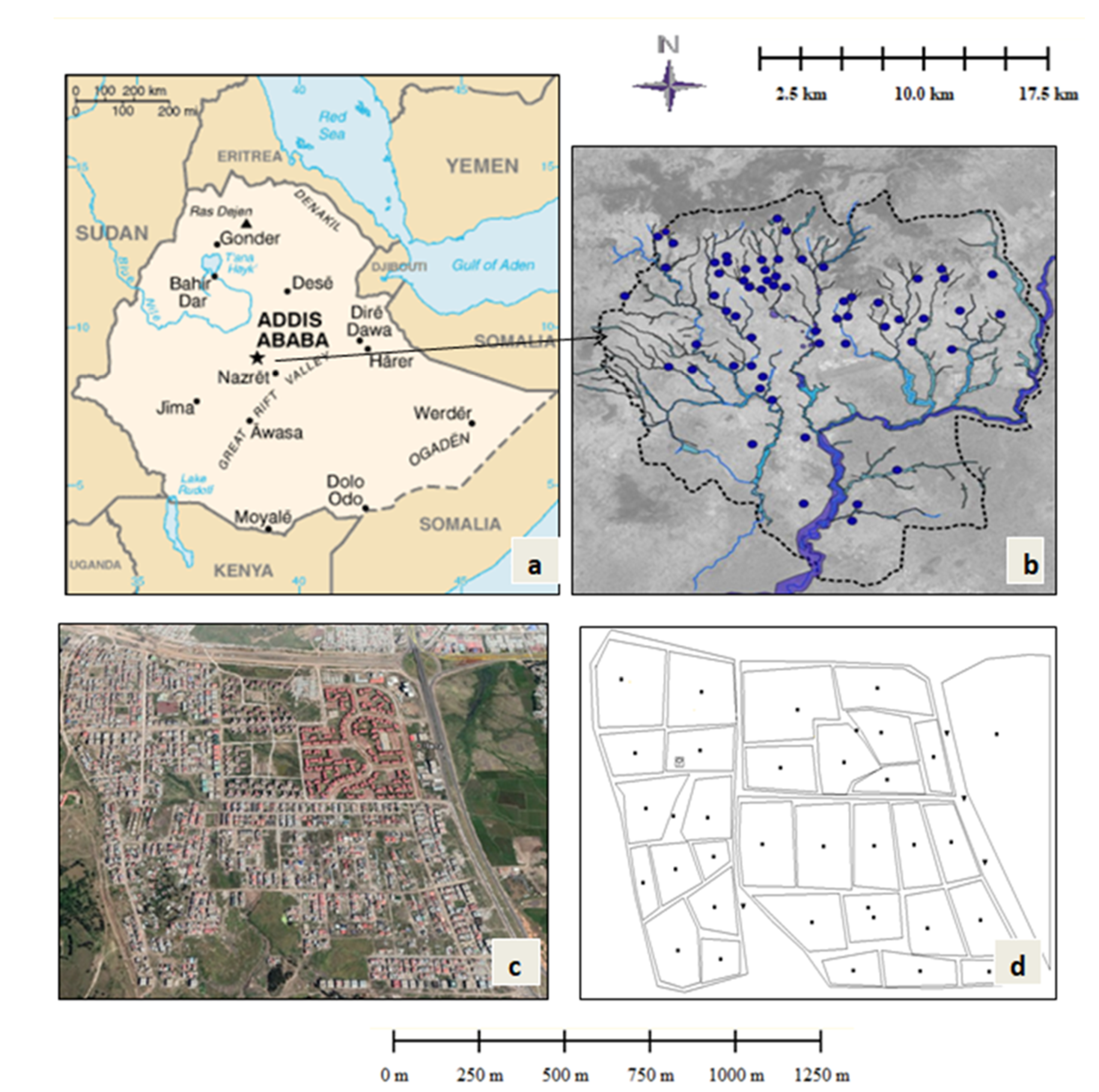
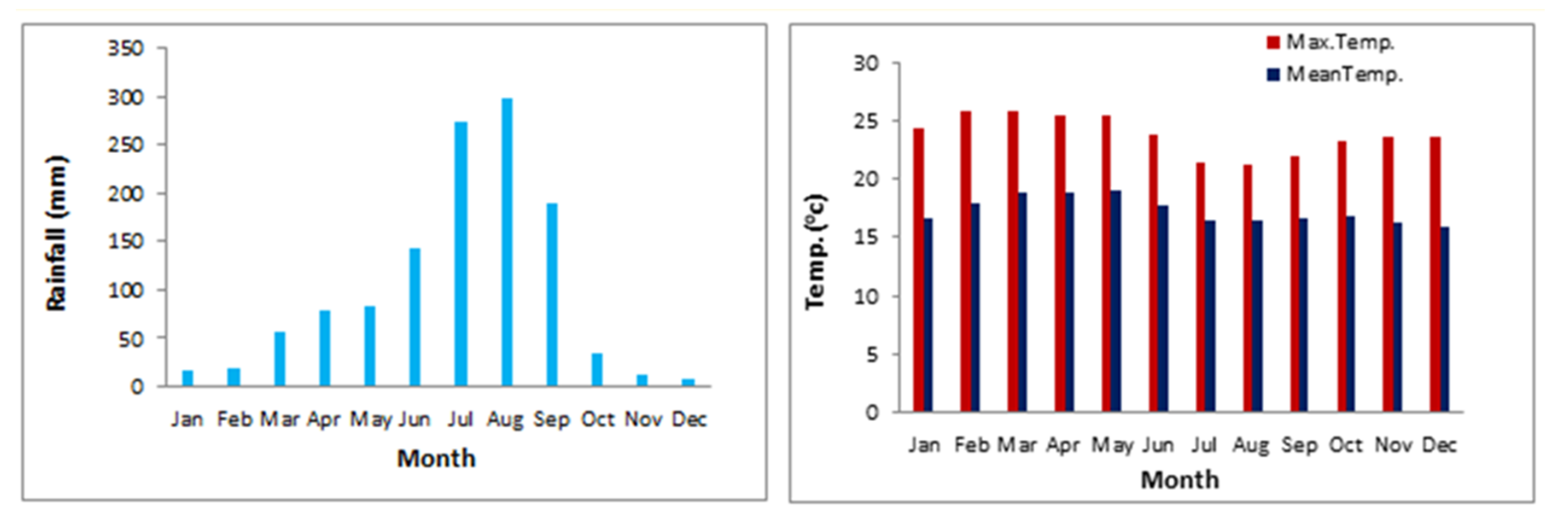

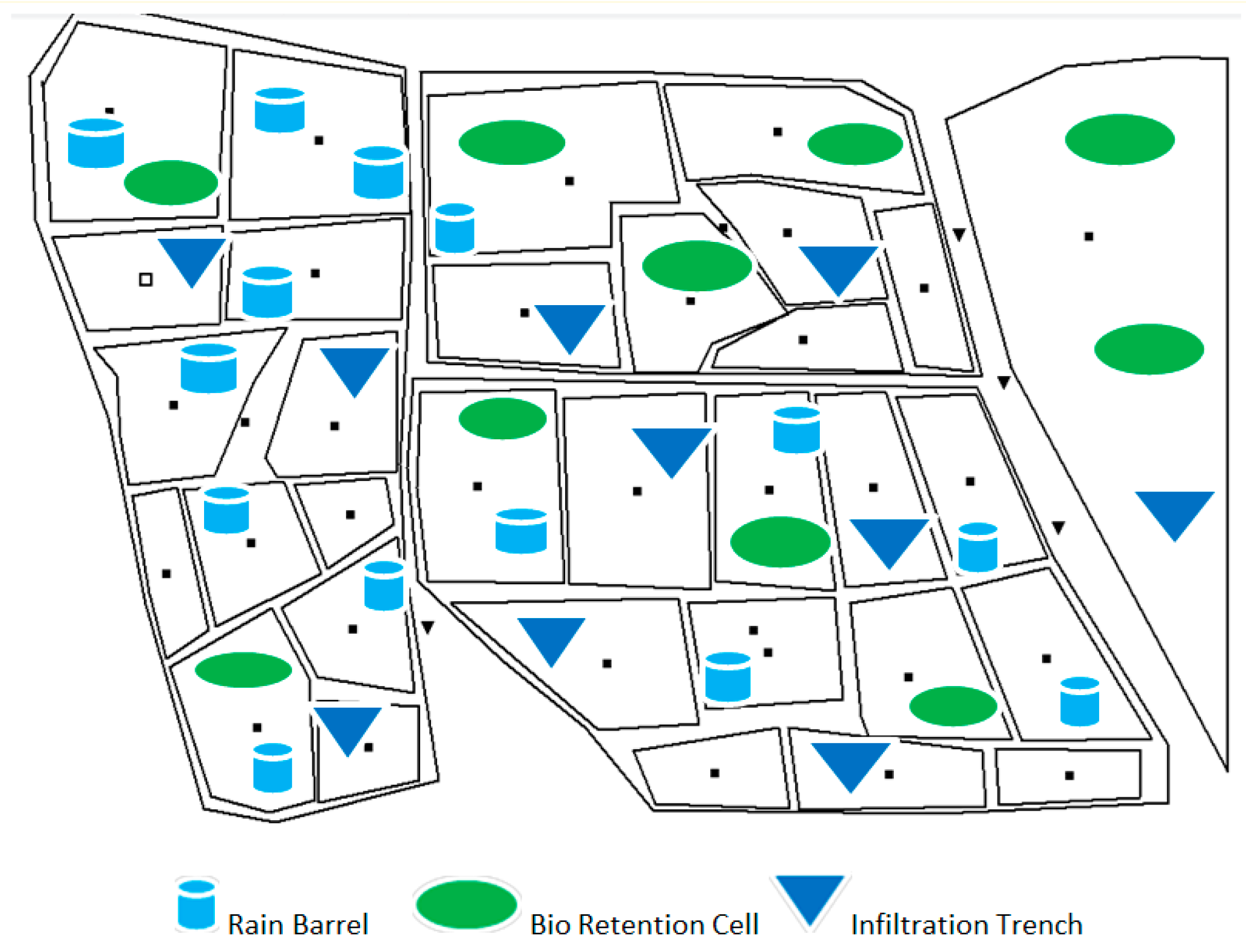

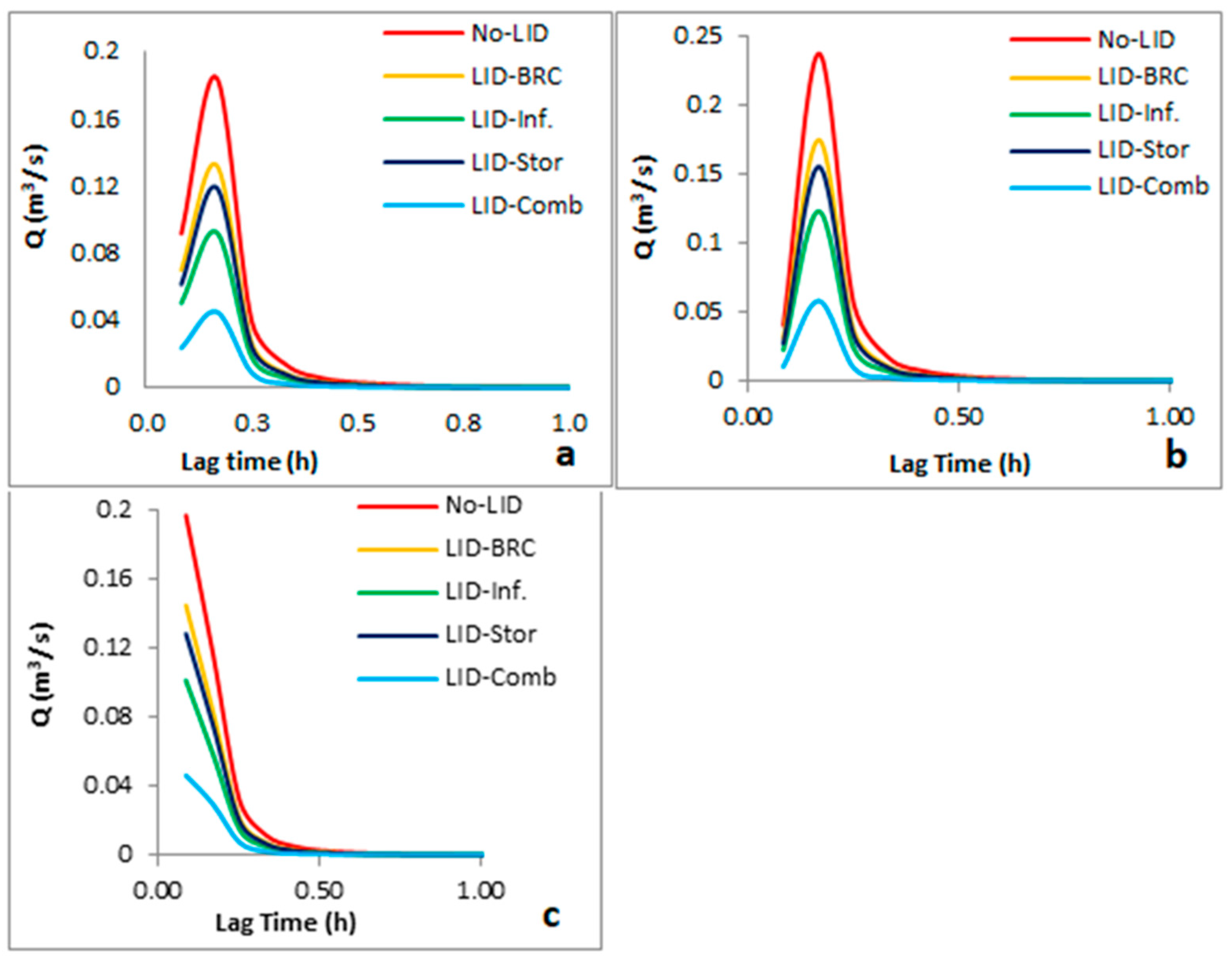
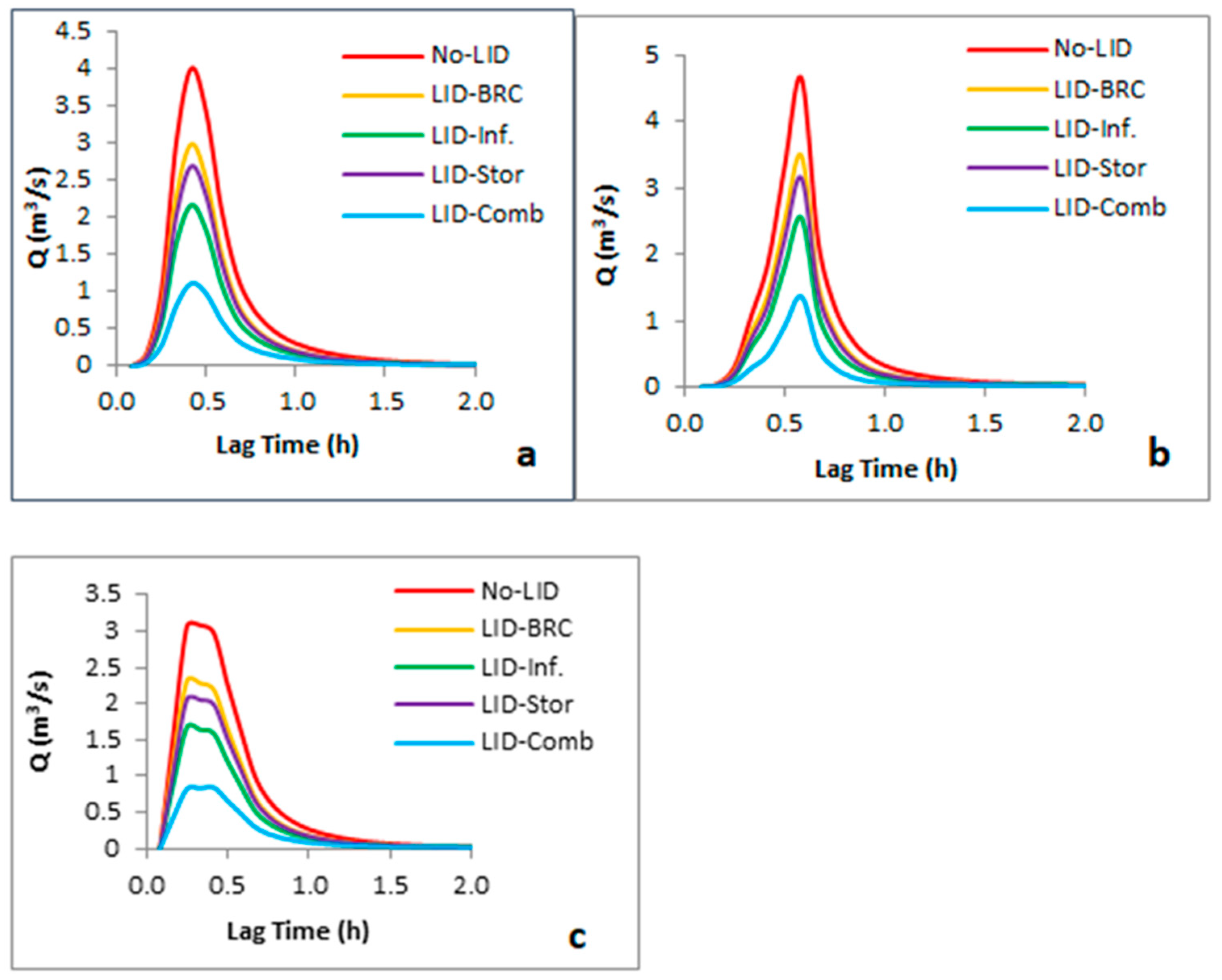
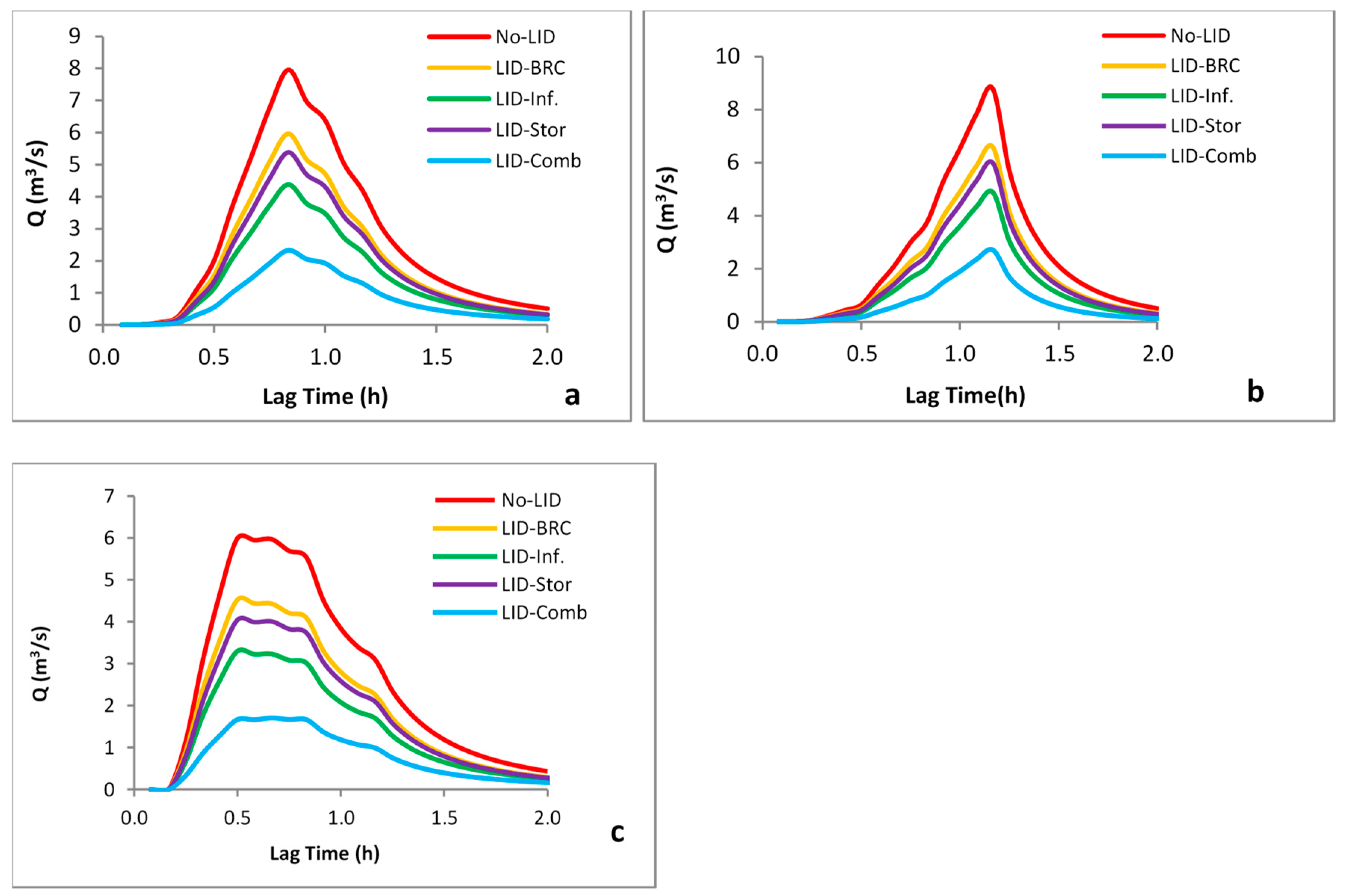
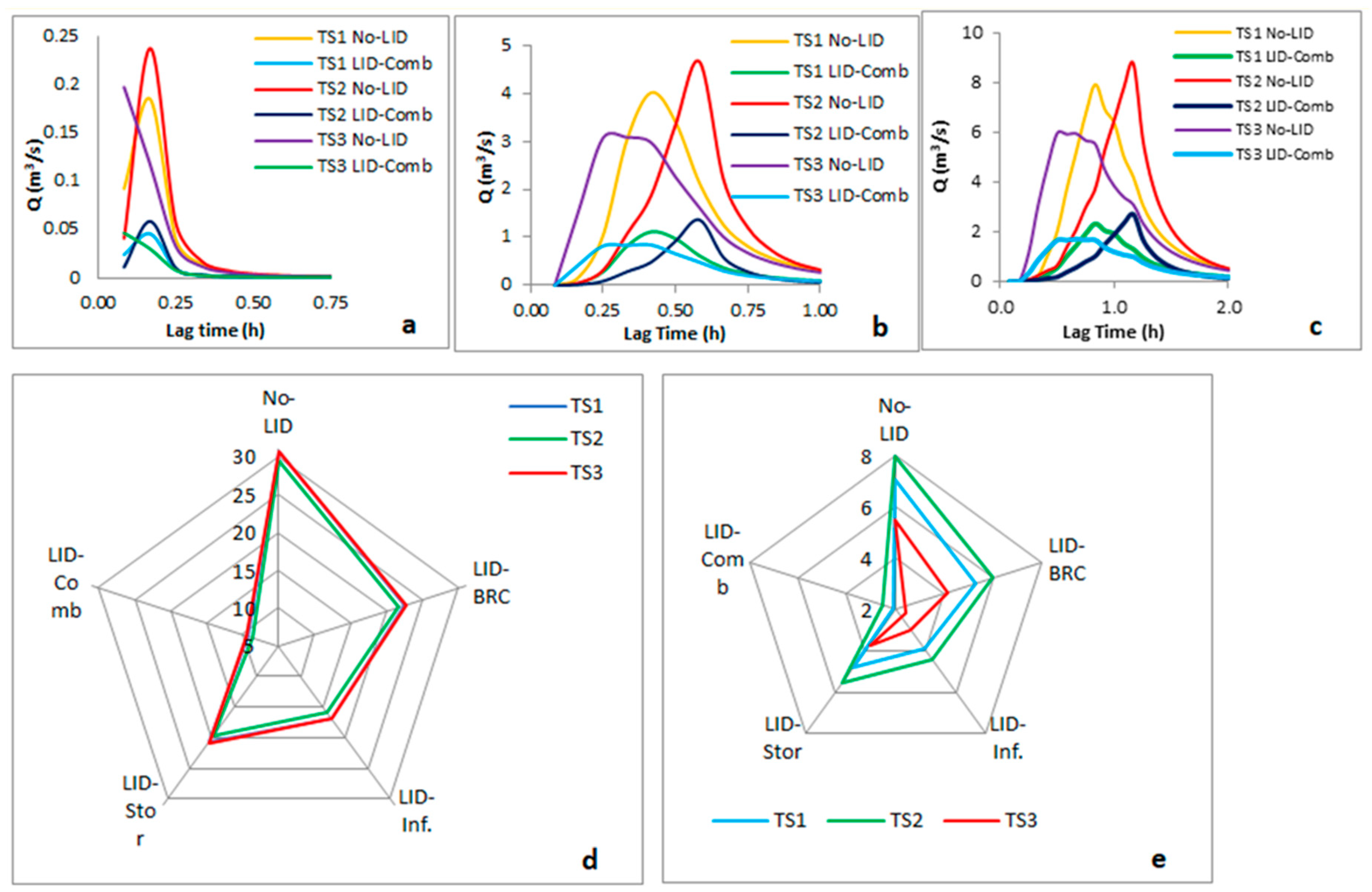
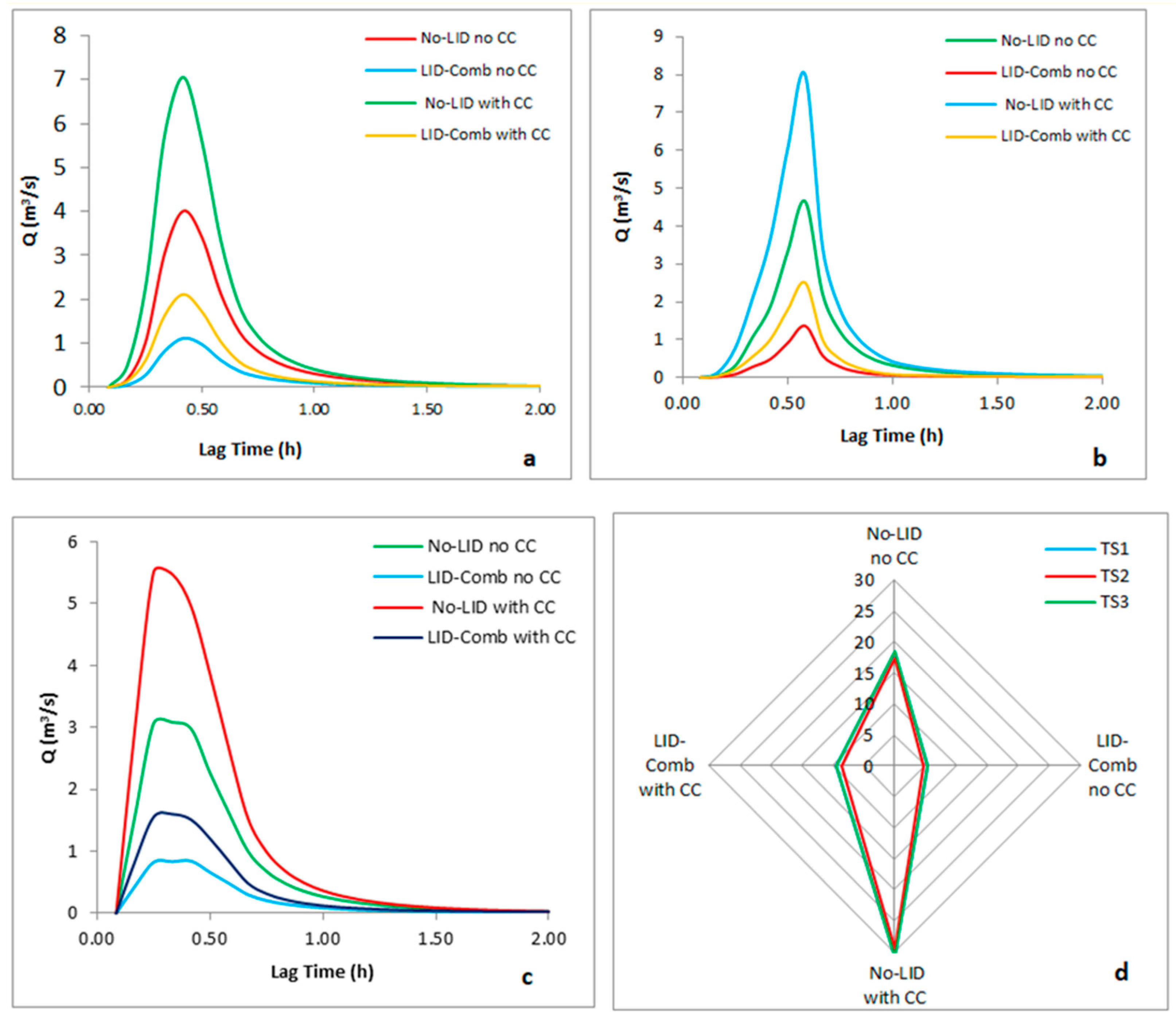

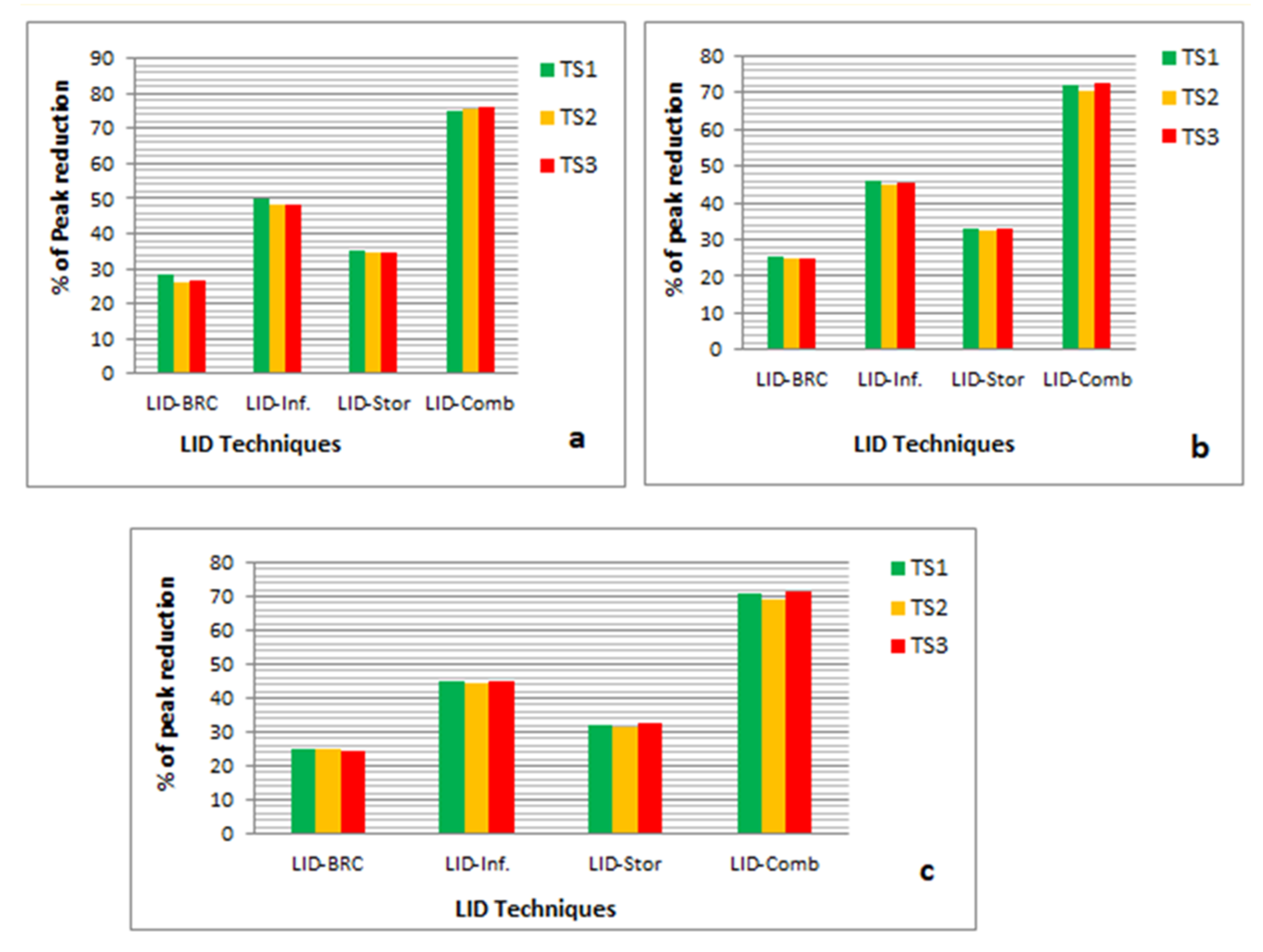
| Extreme PCP Indices. | RCP 4.5 | RCP 8.5 | Reference | Extent of Study | ||||
|---|---|---|---|---|---|---|---|---|
| 2020s | 2050s | 2080s | 2020s | 2050s | 2080s | |||
| Rx1day | 20–25 | 25–30 | 30–35 | 15–20 | 15–20 | 15–20 | [6] | Ethiopia |
| ---- | 7.22 | ---- | ---- | ---- | ---- | [27] | Addis Ababa | |
| ---- | ---- | ---- | ---- | ---- | 15–30 | [26] | Worldwide | |
| Rx5day | 35–40 | 35–40 | 35–40 | 10–20 | 15–20 | 10–20 | [6] | Ethiopia |
| 21 | ---- | ---- | ----- | ----- | 17 | [27] | Addis Ababa | |
| ---- | ---- | ---- | ---- | ---- | 10–30 | [26] | Worldwide | |
| SDII | −4–20 | −4–22 | −5–23 | −12–5.5 | −7–8 | −5–18 | [6] | Ethiopia |
| ---- | ---- | ---- | ---- | ---- | 5–25 | [26] | Worldwide | |
| Total pcp | 40–65 | 40–65 | 40–65 | 15 | 10 | −10 | [6] | Ethiopia |
| ---- | ---- | 29.3 | ---- | ---- | 21 | [27] | Addis Ababa | |
| 95th p | 20 | 25 | 20 | 25 | 5 | 10 | [6] | Ethiopia |
| Pav | ---- | ---- | ---- | ---- | ---- | 5–15 | [26] | Worldwide |
| ---- | ---- | 5–10 | ---- | ---- | 15–30 | IPCC, 2014 | Global | |
| No | Model Parameter | Parameter Definition | Value Range | Initial Value | Final Value |
|---|---|---|---|---|---|
| 1 | N-Imperv | Manning coefficients in impervious areas | 0.006–0.05 | 0.01 | 0.014 |
| 2 | N-Perv | Manning coefficients in pervious areas | 0.08–0.5 | 0.1 | 0.1 |
| 3 | S-Imperv | Depression storage in impervious areas/mm | 0.011–0.24 | 0.02 | 0.05 |
| 4 | S-Perv | Depression storage in pervious areas/mm | 0.2–5 | 0.5 | 2 |
| 5 | Max-Rate | Maximum infiltration rate (mm/h) | 25–75 | 25 | 40 |
| 6 | Min-Rate | Minimum infiltration rate (mm/h) | 0–10 | 2 | 5 |
| 7 | Decay | Infiltration decay constant (1/h) | 2–7 | 3 | 5 |
| 8 | %Zero-Imperv | Percentage of impervious area with no depression storage (%) | 0–100 | 10 | 25 |
| No | Land Use (Catchment Type) | Comprehensive Curve Number Coefficient (CCNC) | Equivalent Runoff Coefficient |
|---|---|---|---|
| 1 | Densely built commercial areas | 78–94 | 0.7–0.9 |
| 2 | Densely built residential areas | 76–92 | 0.6–0.8 |
| 3 | Sparsely built residential areas | 72–88 | 0.5–0.7 |
| 4 | Sparsely populated areas | 70–86 | 0.4–0.6 |
| No | Land Use Type | % Impervious | Area (ha) | Areal Coverage (%) |
|---|---|---|---|---|
| 1 | Built-up (houses) | 75 | 149.16 | 67.8 |
| 2 | Parking lots | 50 | 16.06 | 7.3 |
| 3 | Green areas | 40 | 27.06 | 12.3 |
| 4 | Roads and pavements | 70 | 24.64 | 11.2 |
| 5 | Stream | - | 3.08 | 1.4 |
| Total | - | 220 | 100 | |
| No | LID Type | Area (ha) | Coverage (%) | % of Total Area |
|---|---|---|---|---|
| 1 | Bio-Retention cell | 26.2 | 39.7 | 11.9 |
| 2 | Infiltration trench | 18.4 | 27.9 | 8.4 |
| 3 | Rain Barrel | 21.3 | 32.4 | 9.7 |
| Total | 65.9 | 100 | 30.00 | |
Publisher’s Note: MDPI stays neutral with regard to jurisdictional claims in published maps and institutional affiliations. |
© 2021 by the authors. Licensee MDPI, Basel, Switzerland. This article is an open access article distributed under the terms and conditions of the Creative Commons Attribution (CC BY) license (https://creativecommons.org/licenses/by/4.0/).
Share and Cite
Jemberie, M.A.; Melesse, A.M. Urban Flood Management through Urban Land Use Optimization Using LID Techniques, City of Addis Ababa, Ethiopia. Water 2021, 13, 1721. https://doi.org/10.3390/w13131721
Jemberie MA, Melesse AM. Urban Flood Management through Urban Land Use Optimization Using LID Techniques, City of Addis Ababa, Ethiopia. Water. 2021; 13(13):1721. https://doi.org/10.3390/w13131721
Chicago/Turabian StyleJemberie, Mengistu A., and Assefa M. Melesse. 2021. "Urban Flood Management through Urban Land Use Optimization Using LID Techniques, City of Addis Ababa, Ethiopia" Water 13, no. 13: 1721. https://doi.org/10.3390/w13131721
APA StyleJemberie, M. A., & Melesse, A. M. (2021). Urban Flood Management through Urban Land Use Optimization Using LID Techniques, City of Addis Ababa, Ethiopia. Water, 13(13), 1721. https://doi.org/10.3390/w13131721







